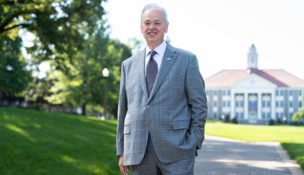Upward mobility
ODU plots path to bigger, more inclusive future
Gary Robertson //September 29, 2022//
Upward mobility
ODU plots path to bigger, more inclusive future
Gary Robertson //September 29, 2022//
Last year, when Old Dominion University was searching for its new president, the executive search firm contracted by the university also provided a bit of business intelligence about how the university of 24,000 students in Norfolk was viewed nationally.
“Old Dominion University was seen as a university on the rise,” says ODU‘s rector, Bruce Bradley, former president and publisher of The Virginian-Pilot newspaper and retired president of Landmark Publishing Group.
That pretty well describes the steady upward transformation that Bradley says he’s observed at ODU during the past few decades.
The university, he says, has gone from being perceived as “an adequate commuter college” to becoming a recognized research and residential university with ambitions to make a larger impact, perhaps on the national stage.
“It’s gotten up a head of steam,” says Bradley, who first came to the Hampton Roads region in 1971 when he began serving in the U.S. Navy.
Founded in 1930 as the Norfolk division of William & Mary and Virginia Tech, ODU became an independent institution in 1962 and achieved university status in 1969.
Bradley says ODU’s 2021 designation as an R1 research university (recognizing it under the Carnegie Classification of Institutions of Higher Education as a doctoral university with a great amount of research activity) was huge.
The R1 designation creates a pathway to recruiting high-quality faculty and students, obtaining large research grants, and attracting industry and government agency partners, the university says.
Equally as significant to ODU’s future are the ongoing efforts by ODU, Eastern Virginia Medical School (EVMS) and Norfolk State University to create the ONE School of Public Health, with support from Sentara Healthcare. There has also been talk about a potential merger of EVMS and ODU.
“If you look at the public health metrics for Hampton Roads, we tend to score near the bottom on every key category,” Bradley says. “So, the thought is, one of the ways we can address the health inequities in this community is [by] combining these two organizations [ODU and EVMS] and funding it more aggressively through Sentara, which has been a willing partner, as well as the [state government].”
ODU also is focused on graduating students who will enter the health care profession and work to create better health outcomes in Hampton Roads. The university says it’s second in the state only to Virginia Tech in producing STEM-H (science, technology, engineering, math and health sciences) graduates — accounting for about 40% of all ODU graduates.
And it wants to produce even more, aiming for growth among students from underrepresented communities and those who are the first in their families to attend college.

Increasing opportunity
ODU, which estimates it has an annual economic impact of about $2.6 billion, also has evolved into one of the commonwealth’s leading institutions for social mobility.
President Brian Hemphill, who became ODU’s first Black president on July 1, 2021, has walked that road himself.
“For me, it was growing up in eastern North Carolina the son of a brick mason, [my] mother a seamstress, and having the opportunity to grow up in humble beginnings on a farm and understanding the importance of hard work,” he says.
Hemphill’s parents worked hard so that he and his seven siblings could go to college, he says. “There was a sense of responsibility to go out and do the best I could every single day.”
Since then, Hemphill has been a strong advocate for increased educational and economic access and opportunity.
“About 28% of our students are African American, and about 49% of our students are from diverse populations or backgrounds,” he says. “We’re one of the few campuses that have a center for social mobility. It is really looking at the opportunity for engaging students and positioning them for success — with services and support, as well as some of their financial needs.”
Formerly president of Radford University, Hemphill notes that 38.1% of ODU’s fall 2020 undergraduates received federal Pell grants, which assist low-income students. That’s compared with an average 26.1% for all of Virginia’s public four-year institutions.
Additionally, last year, the university reported that roughly half of ODU’s incoming freshmen and 25% of its graduating class were first-generation college students.
“That’s an important niche for us to continue to focus on,” says Bradley, ODU’s rector, adding that the success of first-generation students is crucial to the futures of ODU and the region.
During the 2010s, the number of African American students at ODU increased 34% (from 5,211 to 6,846) and the number of Hispanic students jumped 73% (from 1,204 to 2,088), according to data from the State Council of Higher Education for Virginia (SCHEV).
Additionally, approximately 25% of the university’s enrollment consists of distance learners, and ODU has conferred more than 20,000 degrees to online students. Hemphill wants to grow that remote-study enrollment because, he says, the university faces space constraints for in-person lessons on its 337-acre waterfront campus.
ODU’s online degree program began by serving Navy personnel around the world, then through a satellite learning system in partnership with Virginia community colleges before maturing into today’s web-based studies.
Workforce development remains an overarching focus for ODU’s efforts in distance learning and face-to-face instruction, providing employers with assistance to sustain and grow their companies and Virginia’s economy, Hemphill says.
To that end, in June ODU announced plans to create a School of Supply Chain, Logistics, and Maritime Operations, acknowledging the region’s historic roots in the maritime industry and its juxtaposition to the Port of Virginia and Naval Station Norfolk, the world’s largest naval station.
ODU has an established record of leader- ship and collaboration with the maritime industry, Hemphill says, adding that industry partners have asked the university to increase its work in the space.
The university is also increasing its research in coastal resilience and offshore wind, coinciding with timely factors such as sea-level rise and Dominion Energy Inc.’s planned $9.8 billion wind farm in waters 27 miles off the coast of nearby Virginia Beach.
And in September, during his State of the University address, Hemphill announced that ODU plans to launch a School of Data Science in partnership with the Jefferson Lab (Thomas Jefferson National Accelerator Facility) and NASA Langley Research Center, both of which will receive faculty status for researchers. ODU faculty and students in turn would receive access to the national labs’ facilities and have opportunities for research collaborations.

‘The front porch’
ODU has been taking its “on the rise” reputation literally in recent years, making and planning a series of major additions to its physical footprint.
Last year, the university opened its new $75 million chemistry and biochemistry building, which features the 122-seat Michael and Kimthanh Lé Digital Theater and Planetarium, as well as 24 research laboratories and 13 teaching labs.
Also in 2021, the university opened a $62 million residence hall, providing housing for up to 470 students in an environment designed to be a living-learning community for cybersecurity, gaming, health professions and engineering students.
In summer 2023, ODU plans to complete work on its $75 million, three-story Health Sciences Building. Housing the School of Dental Hygiene, the School of Rehabilitation Sciences and the School of Medical Diagnostic and Translational Sciences, the building also will function as a focal point for university community health care initiatives.
During the 2022 General Assembly session, ODU secured $188 million for a new, five-story, 160,000-plus-square-foot Biology Building that’s slated to replace the university’s Mills Godwin Life Sciences Building by 2026.
On the athletics side, in July ODU joined the Sun Belt Conference, which will widen the school’s exposure to ESPN audiences, while roughly halving travel time to away games.
“It’s a great move for our student athletes and fan base,” Hemphill says. “Our fan base is excited to be able to compete against the likes of James Madison, Marshall, Coastal Carolina and Appalachian State.”
Wood Selig, ODU’s director of athletics, says the Sun Belt’s 10-year contract with ESPN was a “game-changer” because of the exposure it will give ODU and its conference rivals, and the access it will provide to ODU fans to follow their favorite teams. Last year, the conference signed a media rights deal with ESPN that will see a 50% increase on Sun Belt football games aired across ABC, ESPN, ESPN2 and ESPNU.
Additionally, ODU, which completed a $67.5 million makeover of its S.B. Ballard football stadium in 2019, announced in September that it had received a $2.5 million donation from Dennis and Jan Ellmer toward the $20 million renovation and expansion of the school’s baseball stadium. Dennis Ellmer is president and CEO of Chesapeake-based Priority Auto Group Inc., a dealership with locations in Hampton Roads, Roanoke and Northern Virginia. Planned in stages, the baseball stadium makeover will include expanded and upgraded seating, luxury suites, a club area, new locker and meeting rooms, and a new press box.
“In many ways, athletics can be the front porch of an institution; it’s certainly a part of the branding and mission,” Selig says. “A well-run athletic program can generate national notoriety, which can help with enrollment growth, out-of-state enrollment interest and elevate the overall brand and perception of the institution in the eye of the public in a very significant and meaningful way.”
And at least one former ODU athlete has elevated the university’s profile as an ambassador in a different realm: poetry.
Last year, ODU alumna Natalie Diaz, who was a point guard and captain of the women’s basketball team, became the first Latina and Native American woman to win a Pulitzer Prize for poetry. A 2000 ODU graduate, she received a John D. and Catherine T. MacArthur Foundation “genius grant” fellowship in 2018 before going on to win the 2021 Pulitzer for “Postcolonial Love Poem,” her collection of what the Pulitzer jury described as “heart-wrenching and defiant poems that explore what it means to love and be loved in an America beset by conflict.”
The next stage for ODU as it seeks to reach wider notice could come this fall when the university will announce what Hemphill says will be the largest fundraising campaign in ODU’s history.
“There are a lot of things I’m proud of, and it starts with our faculty, our staff and our students,” Hemphill says. “They are the drivers behind the growth and momentum of this great institution.”
ODU at a glance
Founded
Old Dominion University was founded in 1930 as a two-year school to train teachers and engineers as an extension of William & Mary and Virginia Tech.
It gained independence in 1962 as Old Dominion College and began offering master’s degrees in 1964 and doctoral degrees in 1971. It was renamed
Old Dominion University in 1969.
Campus
Old Dominion has seven academic colleges and three schools. Its 337-acre Norfolk campus is bordered on two sides by the Elizabeth and Lafayette rivers. The school also operates regional higher educational centers in Virginia Beach, Portsmouth and Hampton.
Enrollment1
Undergraduate: 18,363
Graduate: 4,656
In-state: 20,178
International: 717
Students of color: 11,5902
Employees: 2,474
Faculty: 915 full-time
Tuition and fees
In-state tuition and fees: $11,630
Tuition and fees (out of state): $31,580
Room and board: $14,116
Average financial aid awarded to full-time freshmen seeking assistance: $15,987
1 Fall 2022 enrollment statistics
2 2021-22 data

















